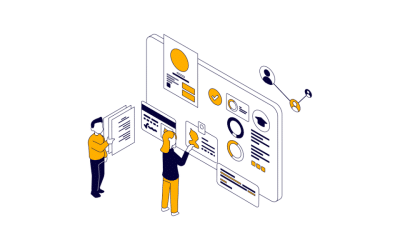>We explore the slow-pace of change by financial lenders from online customer applications workflows with binary decisioning to iterative digital onboarding decisioning and ask the question why this obvious next-stage in online lending evolution is taking so long.
Since the start of statistical assessment of credit risk, the outcomes have been binary – the “Goods” are separated from the “Bads.” This was good enough to manage bad debt and ensure the “Goods” paid for the “Bads.” But that was before the FCA.
The traditional ‘yes or no’ response to a generic applications request is insufficient to cope with the diversity of the online lending audience that includes vulnerable customers, individuals that lack access to bank accounts, and people beginning their application journey from a variety of different start-points in the personal finance lifecycle.
Why? Because the majority of transformative agendas have focused on reducing back-office complexity and inefficiency, for internally focused cost and speed benefits. Customers’ time to serve has reduced, but little else. Customer front-ends have remained largely untouched, for years in some cases. Where customers used to be filling out paper application forms, they now complete the same standard forms online, asking for information not required from one group of customers, not asking important questions for other groups.
The Binary Decisioning Problem
Digital engagement today is binary: not because computers work in ones and zeros, but because digital journeys are created as a ‘one size fits all’ solution. Faced with these options, customers have just two choices presented to them; either answer everything, or be declined. On the other side of the binary decisioning fence, lenders themselves have two choices; They must decide whether they have enough to establish that lending is responsible, or decline the customer.
Julian Graham-Rack, CEO for PrinSIX explains,
“Decline is the go-to solution to manage regulatory risk in today’s market. But to decline an applicant is a poor customer outcome, as the lender is declining access to financial services to those that may need them but whose circumstances don’t ‘fit the model.’ Equally, the decision to decline an applicant is a poor commercial outcome because it reduces commercial opportunity, maybe unnecessarily.”
The New Lending Reality
From 2014, a new risk materialised—compliance risk associated with responsible lending. The FCA asked the question, ‘Is lending affordable, sustainable, suitable, and with due regard for customers’ potential vulnerabilities?’ Since then, the FCA has further added to their definition of vulnerability, by identifying four core cohorts, namely Financial Resilience, Health, Capability and Life Events. Within each of these, there are many examples of what might trigger each category. But the assessment method of this escalating risk is the same as credit risk – split the regulatory “Goods” from the regulatory “Bads”.
What’s the learning lesson we take from all this? It’s that the binary ‘YES/NO’ applications process needs to be displaced with near-real-time iterative decisioning that fine-grains applicant journeys into much smaller cohorts of applicants—so every customer is treated individually, so every customer is treated fairly.
Taking the human approach
The real world is not binary. Everyone has complex and unique lives, so why are we still trying to split everyone into only two cohorts?
Graham-Rack adds,
“In the real-world, people are not understood by asking them a fixed set of questions. If you interview for a job, you don’t go down a fixed list of questions, then decide whether to hire or not. You ask a question, listen to the answer, and then start a conversation. You probe, explore, and test understanding of people. The next question comes from what went before. You know what you need to understand, but you don’t use a script. Why treat digital differently? You need digital conversations, but today’s binary journeys don’t deliver them.”
The Alternative to Binary Decisioning?
Using a personalised digital onboarding solution, underpinned by point-and-click editing tools, digital conversations can be made adaptive and responsive. Journeys can be dynamic to treat every applicant as an individual. Conversations that stop as soon as they reasonably can but continue for as long as needed to truly understand the customer. They need to develop, learn and improve quickly. They need to be adaptable to different circumstances
That means no more ‘one size fits all.’ No more binary decisioning cohorts, but multiple cohorts, with multiple potential outcomes to serve more groups of customers, better. ‘Not sure, Decline’ decisions are prevented by adopting onboarding journeys that extend until the right decision can be made with confidence.
To learn more about the possibilities of personalised onboarding as a route to (1) obviating FCA Principle 6 risks, (2) maximising the value of Open Banking data, and (3) addressing vulnerability options, read the FCA Sandbox White Paper.



